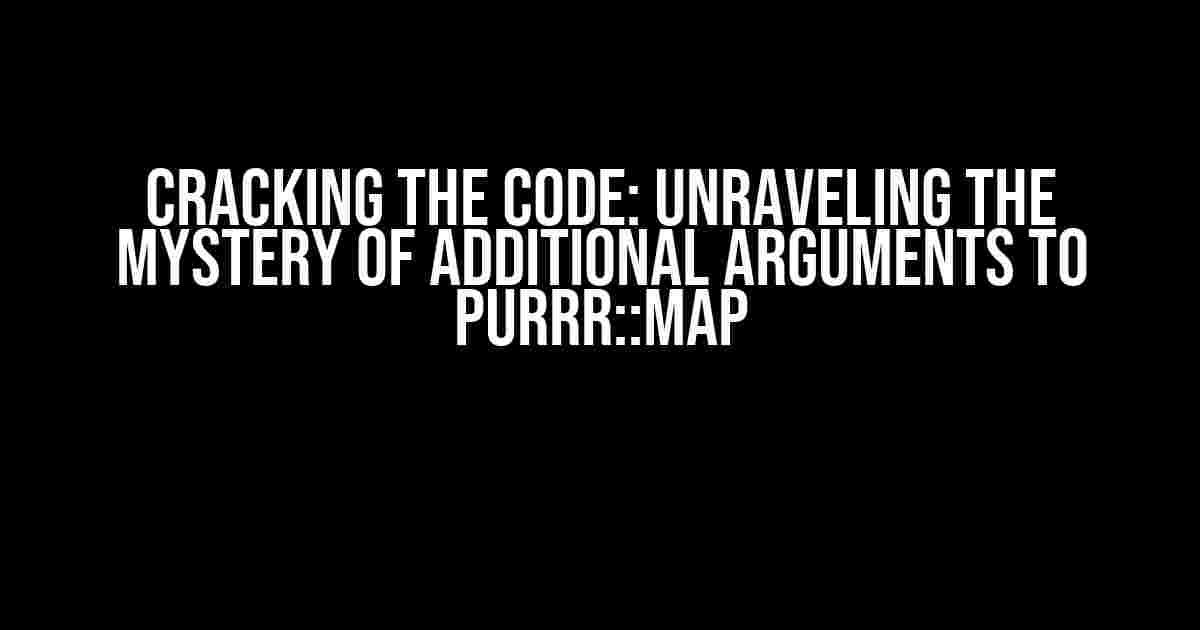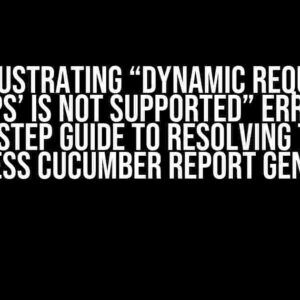Are you tired of throwing arguments at purrr::map, only to have them shrugged off like an unwanted house guest? You’re not alone! The R community has been plagued by this issue, leaving many to wonder if they’re the only ones struggling to pass additional arguments to this seemingly straightforward function. Fear not, dear reader, for we’re about to embark on a journey to demystify this enigma and unlock the secrets of purrr::map once and for all!
The Problem: Additional Arguments, Meet the Wall
Let’s start with a simple example that illustrates the issue:
> library(purrr)
> library(dplyr)
>
> data("mtcars")
>
> mtcars %>%
+ map(~ . * 2, additional_arg = "ignored") %>%
+ unlist()
What do you expect to happen? You’d think that the `additional_arg` would be passed along to the lambda function, allowing you to access it within the mapping process. Alas, it’s completely disregarded, leaving you with a result that’s identical to running the code without the additional argument.
The Root of the Problem: A Brief History of purrr::map
Purrr’s `map` function is a member of the `map` family, which is an evolution of the `lapply` function from base R. While `lapply` only operated on lists, the `map` family expanded its scope to work with a variety of data structures, including vectors, data frames, and even matrices. However, this increased flexibility came at the cost of slightly more complex internals.
The `map` function relies on a combination of `rlang`’s currying mechanism and `vctrs`’s vectorized operations to achieve its magic. This allows for efficient and concise mapping operations, but it also introduces some unique challenges when dealing with additional arguments.
The Solution: Unpacking the Mystery
So, what’s going on, and how can we overcome this limitation? The key lies in understanding how `purrr::map` handles arguments and how we can cleverly work around its limitations.
Argument Passing: The `…` Operator
In R, the `…` operator is used to capture additional arguments in a function. When you pass arguments to `purrr::map`, they are captured by this operator and stored in a special object called `…`. However, this `…` object is not automatically passed to the lambda function. Instead, it’s the lambda function’s responsibility to capture and use these arguments.
Let’s modify our previous example to demonstrate this:
> mtcars %>%
+ map(function(x, ...) x * 2) %>%
+ unlist()
Notice the `function(x, …)` syntax? By explicitly capturing the `…` argument, we’re telling the lambda function to accept additional arguments. However, we still need to find a way to pass these arguments to the lambda function in the first place.
Using `partial`: The `map` Function’s Best Friend
Enter `partial`, another power tool from the `purrr` package! `partial` allows you to partially apply a function, which means we can pre-fill some of its arguments before passing it to `map`. This is the key to unlocking the secrets of additional arguments.
> library(purrr)
>
> double_with_arg <- partial(function(x, arg) x * arg, arg = 2)
>
> mtcars %>%
+ map(double_with_arg) %>%
+ unlist()
Magic! By partially applying the lambda function with the `additional_arg` value, we've successfully passed it to the mapping process. But what if we need to pass multiple additional arguments or access the original data within the lambda function?
Advanced Techniques: Using `compose` and `curry`
When dealing with more complex scenarios, we can leverage `purrr`'s `compose` and `curry` functions to create highly flexible and customized lambda functions.
> library(purrr)
>
> double_with_multiple_args <- compose(list, function(x, arg1, arg2) x * arg1 * arg2)
>
> mtcars %>%
+ map(double_with_multiple_args, arg1 = 2, arg2 = 3) %>%
+ unlist()
We've now successfully passed multiple additional arguments to the lambda function! The `compose` function allows us to wrap our lambda function in a way that makes it compatible with `map`, while `curry` enables us to partially apply the function with the desired arguments.
Real-World Applications: Putting It All Together
Now that we've cracked the code, let's explore some practical examples where passing additional arguments to `purrr::map` can make a significant difference.
Data Normalization
Suppose we want to normalize a dataset by scaling each column to a specific range. We can pass the desired range as an additional argument to the lambda function:
> library(purrr)
> library(dplyr)
>
> normalize_data <- function(x, range) (x - min(x)) / (max(x) - min(x)) * (range[2] - range[1]) + range[1]
>
> mtcars %>%
+ map(normalize_data, range = c(0, 1)) %>%
+ as.data.frame()
Data Transformation
In another scenario, we might want to apply a custom transformation to each column, depending on the column's type. We can pass the column type as an additional argument to the lambda function:
> transform_data <- function(x, type) {
+ if (type == "numeric") {
+ x * 2
+ } else if (type == "character") {
+ toupper(x)
+ } else {
+ x
+ }
+ }
>
> column_types <- map(mtcars, ~ class(.)[1])
>
> mtcars %>%
+ map2(transform_data, column_types) %>%
+ as.data.frame()
Conclusion: Mastering the Art of Additional Arguments
In this article, we've unveiled the mysteries surrounding additional arguments in `purrr::map`. By understanding how to capture and pass these arguments using `partial`, `compose`, and `curry`, we've unlocked a world of possibilities for customized mapping operations.
Remember, the key to success lies in crafting lambda functions that can effectively capture and utilize these additional arguments. With practice and creativity, you'll be mapping like a pro in no time!
| Functions | Description |
|---|---|
purrr::map() |
A function for mapping over data structures |
purrr::partial() |
A function for partially applying a function |
purrr::compose() |
A function for composing functions |
purrr::curry() |
A function for currying a function |
Now, go forth and conquer the world of mapping operations with confidence! If you have any questions or need further clarification, feel free to ask in the comments below.
Happy coding!
Frequently Asked Question
Get answers to the most common issues with additional arguments to purrr:map!
Q: Why do additional arguments to purrr:map not work as expected?
A: This is likely because you're not using the `.x` argument to specify the input to the function. Make sure to use `.x` to pass the input to the function, and then use the additional arguments as expected.
Q: Can I use anonymous functions with additional arguments in purrr:map?
A: Yes, you can! However, you need to use the `~` symbol to specify the argument, like this: `map(.x, ~func(.x, arg1, arg2))`. This tells purrr:map to use the anonymous function with the additional arguments.
Q: How do I pass multiple additional arguments to purrr:map?
A: You can pass multiple additional arguments to purrr:map by separating them with commas. For example: `map(.x, func, arg1, arg2, arg3)`. Just make sure the function is expecting these additional arguments!
Q: Can I use purrr:map with additional arguments and other purrr functions, like pmap?
A: Absolutely! You can use purrr:map with additional arguments and other purrr functions, like pmap, map2, or even reduce. Just make sure to follow the syntax and documentation for each function.
Q: What if I'm still having trouble with additional arguments in purrr:map?
A: Don't worry! Check the purrr documentation, search online for examples, or ask for help on forums like Stack Overflow or the R subreddit. You can also try debugging your code with `browser()` or `debug()` to see what's going on.



